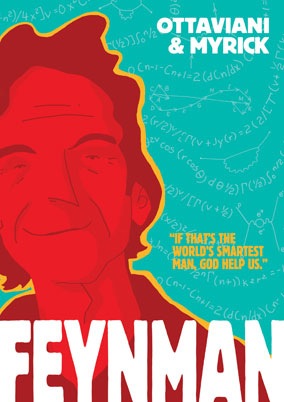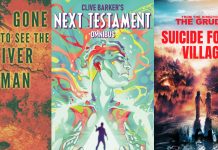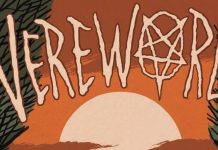
11 Books You Never Thought You’d Read (but Will Fall in Love with Instantly):
Like most of us, you’ve probably heard of graphic novels—but haven’t read too many. Here are 10 new titles (plus one classic) that make you think, feel and daydream just like any other book.
The list includes works by Lynda Barry, “Andres Nilsen” (BIG QUESTIONS— good pick, Oprah!) and FEYNMAN by Jim Ottaviani and Leland Myrick. But as Johanna Draper Carlson (who we got this item from) pointed out the rest of the list wasn’t even graphic novels:
The rest tend towards illustrated poetry (several volumes), a travelogue, art inspired by a novel, and illustrated Craigslist personal ads. There’s a distinct lack of story in these selections, as though a comic, a fully integrated combination of words and images, is still scary. I know that the audience for this list is very different from the usual comic reader, but I get the feeling someone thought it was better to stick with familiar subjects with illustrations than include too many “real” comic works.
The commentary on each book is equally “beginner friendly”:
Graphic biographies are different from regular biographies. They don’t list as many specific details or facts. They don’t go into as much depth or history. But they are, in general, easier and more fun. This quality encourages you to pick them up, even when they’re about people many readers haven’t heard of…like Richard Feynman, a genius in the field of quantum electrodynamics who worked with Einstein and Oppenheimer.
Okay that was an easy one. So now write up Lynda Barry:
One of the most moving and emotionally direct forms of the whole graphic genre is the memoir⎯in part because it allows for all kinds of inventive approaches to telling life stories, such as using the drawings to show how people look and feel to the writer (a huge, tall, monstery dad, for example). It also helps to have thoughtful, deeply poignant writing, which is exactly what you’ll find in Lynda Barry’s What It Is.
Okay you passed. Now BIG QUESTIONS, a 500 page book about talking birds:
Big Questions is just what a novel should be, if by novel we mean a very long story that creates an entire imaginary universe that involves us so deeply that we begin to think of ourselves as characters within it. The book is 585 pages long (not including appendixes), a number that might seem overwhelming in a traditional format. In this case, you’ll finish in two days, not only because graphic novels contain a lot less text but also because you’ll race through the first time, desperate to figure out the big stuff, only to turn around and reread it in order to figure out all the little stuff you missed.
The writers seem to be on firmer ground with the non-graphic novels, where they don’t have to explain why these genres work at all.
Although the whole well-meaning list smacks of an intern on her lunch break, it does make The View look like Newsarama where comics are concerned.







It’s not a graphic novel, Percy.
I’m kinda lost here…what are we complaining about?
Wonderstruck is the follow-up novel by Brian Selznick, who wrote The Invention of Hugo Cabret. It weaves a silent graphic narrative around and through the text narrative, in a way that is similar to, yet unique from, Hugo Cabret. Highly recommended, especially if you live in or near New York City.
Missed Connections: Love, Lost & Found pairs words and pictures in much the way early broadsheet comics did. The text is on the image, but separate, as a caption, not as dialogue. Is it sequential? No. Is it comics? Sure.
Radioactive is an illustrated biography. Like the “____ for Beginners” series by Writers & Readers Publishing, it’s not a graphic novel.
Moby Dick is an artist’s book, obliterating the words with pictures.
Of Lamb is a picture book.
Everything Is Its Own Reward uses words and pictures, sometimes the words are the picture, to communicate. Yes, comics.
No preview available for Conference of the Birds, I’ll Be Dead by the Time You Read This
If you search that website for “graphic novels”, the first title listed is “The Professor’s Daughter”.
As for Oprah, yeah, it’s probably a member of the diaspora trying to promote graphic novels, so, every little bit helps.
Better than some patronizing “This is a grapic novel. It’s like a comic book, but better.” spiel.
Incidentally, #8 on the list, Moby Dick in Pictures: One Drawing for Every Page is by my friend and fellow PANEL Collective member Matt Kish.
552 illustration done roughly at the rate of a page a day. An amazing feat of creativity and endurance. Please check out Matt’s blog (and you can also preview many of the pages from the book at the Amazon link above).
Thank you Dara, that was very kind of you.
I think it’s worth mentioning that at no point during the conception, execution, or publication of my book did I ever position it or describe it as a graphic novel. In fact, in many of the interviews I did where the subject came up, I was careful to emphasize that my illustrations were definitely not a graphic novel or a storyboard or even a strictly illustrated version of the book. They were, and they remain, personal visual responses to and explorations of this novel.
While it was an honor to be mentioned on this list and see my book receive such wide exposure, it’s important to note that these things are written by people we’ve often never met or even corresponded with.